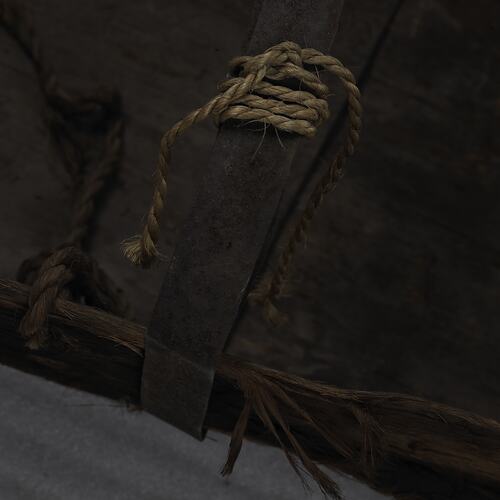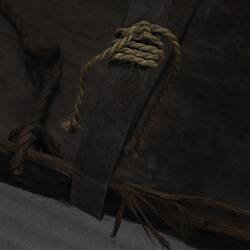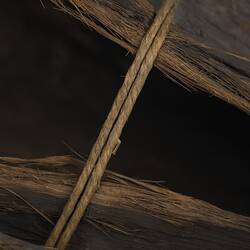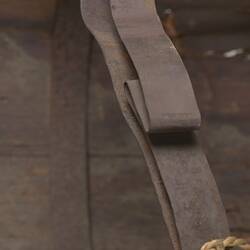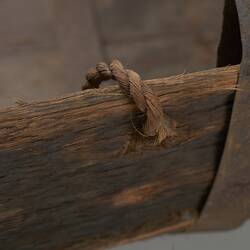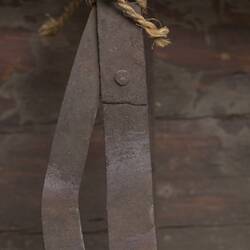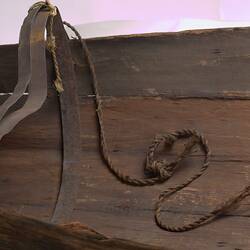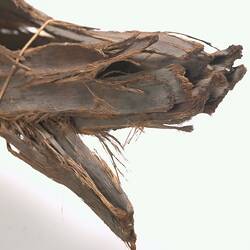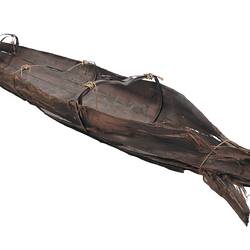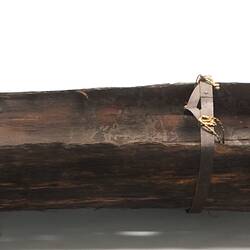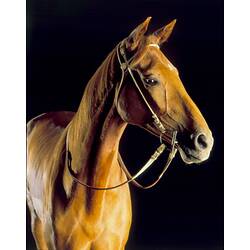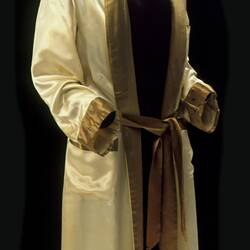Summary
This bark canoe most likely was made by and used by Wurundjeri people, the Woi wurrung speaking clans whose country extended from the lower Yarra to the mountains east of Melbourne. It is is the only surviving nineteenth century canoe from the Melbourne region and is a single sheet of bark taken from the Mountain Ash (Eucalyptus regnans). It is probable that the canoe was made in the hills east of Melbourne and brought down the Yarra River, a distance of over 50 kilometres. Information on the provenance of the canoe is sketchy, however it was collected by John Buchan or his son John Innerarity Buchan who lived in Kew, Victoria, and was most likely on their property Finhaven, adjacent to the Yarra River in Studley Park, Kew, at the time they acquired the property around 1872. The canoe came to the museum via E.J. Reed, who rescued it from a demolition pile of Buchan's house in January 1941.
Dating the canoe precisely is difficult. It is extremely unlikely that Aboriginal people would have been camping in the area around Studley Park and Kew as late as the 1870s. By this time the surviving Woi wurrung speaking people of the Wurundjeri clans had settled at Coranderrk Aboriginal Reserve near Healesville, 65 kilometres east of Melbourne. It is therefore more likely that the canoe had been sitting near the banks of the Yarra River for some years before being collected and stored by the Buchans.
Bark canoes were made in a number of different ways somewhat dictated by the type of bark that was used in their construction. Essentially sheets of bark removed from trees were placed over a fire in order to make it pliable to shape and in southeastern Australia the ends were folded and tied with rope and plugged with clay where needed. Along the Murray River, an entire piece of wood in the shape of a canoe was cut from a tree and then hardened over a fire and propelled through the watercourses using long poles.
Physical Description
A monohull made from a single sheet of bark, most likely from a Mountain Ash (Eucalytus regnans). It is folded and tied at both ends. Metal hoops are wound around the outside and the inside in three places along the hull; namely near the centre and at one end. Rope is tied around one end and other ropes are secured at different points. A number of small distinctive marks are burnt into the bottom of the hull on the inside.
Significance
This is the only extant example of an Indigenous bark canoe from the Melbourne region, and is one of a handful of tied bark canoes from Victoria. The metal hoops and some of the rope may not have been part of the original construction. This canoe is listed on the Australian Register of Historic Vessels (HV000527).
More Information
-
Object/Medium
Canoe
-
Maker
-
Locality
-
Date Produced
-
Collector
-
Date Collected
-
Object Measurements
4515 mm (Length), 615 mm (Width), 320 mm (Height)
-
Keywords
-
References
[Book] Museum Victoria. 2004. Treasures of the Museum. Victoria, Australia. 206.
[Book] Rasmussen, Carolyn. 2001. A Museum for the People: A History of Museum Victoria and its predecesors, 1854-2000.
-
Type of item
-
Discipline
-
Category
-
Collecting Areas
